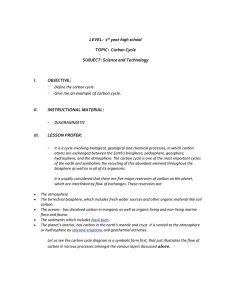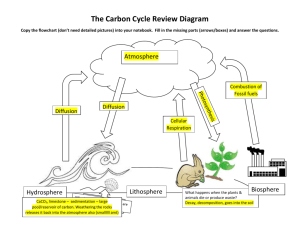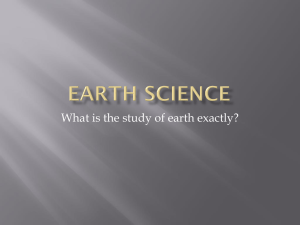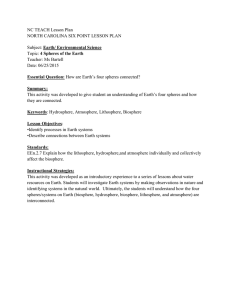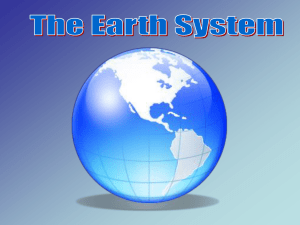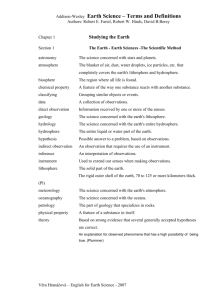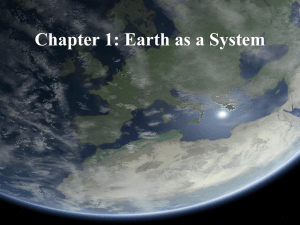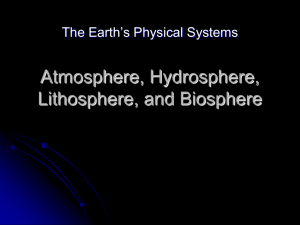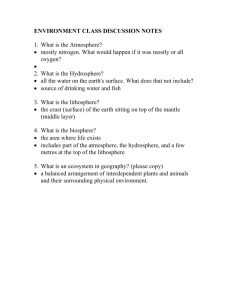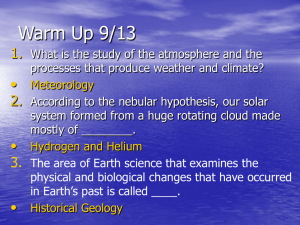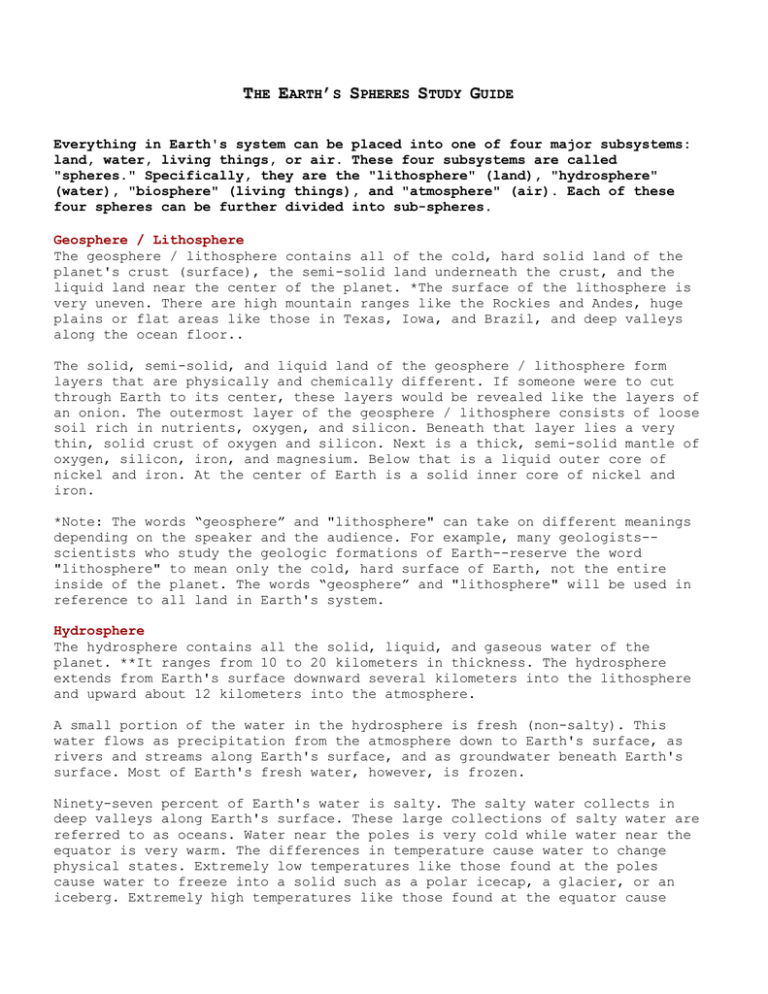
THE EARTH’S SPHERES STUDY GUIDE
Everything in Earth's system can be placed into one of four major subsystems:
land, water, living things, or air. These four subsystems are called
"spheres." Specifically, they are the "lithosphere" (land), "hydrosphere"
(water), "biosphere" (living things), and "atmosphere" (air). Each of these
four spheres can be further divided into sub-spheres.
Geosphere / Lithosphere
The geosphere / lithosphere contains all of the cold, hard solid land of the
planet's crust (surface), the semi-solid land underneath the crust, and the
liquid land near the center of the planet. *The surface of the lithosphere is
very uneven. There are high mountain ranges like the Rockies and Andes, huge
plains or flat areas like those in Texas, Iowa, and Brazil, and deep valleys
along the ocean floor..
The solid, semi-solid, and liquid land of the geosphere / lithosphere form
layers that are physically and chemically different. If someone were to cut
through Earth to its center, these layers would be revealed like the layers of
an onion. The outermost layer of the geosphere / lithosphere consists of loose
soil rich in nutrients, oxygen, and silicon. Beneath that layer lies a very
thin, solid crust of oxygen and silicon. Next is a thick, semi-solid mantle of
oxygen, silicon, iron, and magnesium. Below that is a liquid outer core of
nickel and iron. At the center of Earth is a solid inner core of nickel and
iron.
*Note: The words “geosphere” and "lithosphere" can take on different meanings
depending on the speaker and the audience. For example, many geologists-scientists who study the geologic formations of Earth--reserve the word
"lithosphere" to mean only the cold, hard surface of Earth, not the entire
inside of the planet. The words “geosphere” and "lithosphere" will be used in
reference to all land in Earth's system.
Hydrosphere
The hydrosphere contains all the solid, liquid, and gaseous water of the
planet. **It ranges from 10 to 20 kilometers in thickness. The hydrosphere
extends from Earth's surface downward several kilometers into the lithosphere
and upward about 12 kilometers into the atmosphere.
A small portion of the water in the hydrosphere is fresh (non-salty). This
water flows as precipitation from the atmosphere down to Earth's surface, as
rivers and streams along Earth's surface, and as groundwater beneath Earth's
surface. Most of Earth's fresh water, however, is frozen.
Ninety-seven percent of Earth's water is salty. The salty water collects in
deep valleys along Earth's surface. These large collections of salty water are
referred to as oceans. Water near the poles is very cold while water near the
equator is very warm. The differences in temperature cause water to change
physical states. Extremely low temperatures like those found at the poles
cause water to freeze into a solid such as a polar icecap, a glacier, or an
iceberg. Extremely high temperatures like those found at the equator cause
water to evaporate into a gas.
**Note: Some scientists place frozen water--glaciers, icecaps, and icebergs-in its own sphere called the "cryosphere." However, frozen water will be
included as part of the hydrosphere. The word "hydrosphere" will be used in
reference to all water in Earth's system.
Biosphere
The biosphere contains all the planet's living things. ***This sphere includes
all of the microorganisms, plants, and animals of Earth.
Within the biosphere, living things form ecological communities based on the
physical surroundings of an area. These communities are referred to as biomes.
Deserts, grasslands, and tropical rainforests are three of the many types of
biomes that exist within the biosphere.
It is impossible to detect from space each individual organism within the
biosphere. However, biomes can be seen from space.
Atmosphere
The atmosphere contains all the air in Earth's system. ****It extends from
less than 1 m below the planet's surface to more than 10,000 km above the
planet's surface. The upper portion of the atmosphere protects the organisms
of the biosphere from the sun's ultraviolet radiation. It also absorbs and
emits heat. When air temperature in the lower portion of this sphere changes,
weather occurs. As air in the lower atmosphere is heated or cooled, it moves
around the planet. The result can be as simple as a breeze or as complex as a
tornado.
****Note: The atmosphere is made up of many layers that differ in chemical
composition and temperature. However, we will not differentiate among the
layers of the atmosphere. The word "atmosphere" will be used in reference to
all of the layers.
Privacy Statement and Copyright © 1997-2004 by Wheeling Jesuit
University/NASA-supported Classroom of the Future. All rights reserved.
Permission to make digital or hard copies of part or all of this work for
personal or classroom use is granted provided that copies are not made or
distributed for profit or direct commercial advantage and that copies bear
this notice and the full citation on the first page.
http://www.cotf.edu/ete/ess/ESSspheres.html
Essential
Characteristics
Non - Essential
Characteristics
Geosphere
Examples
Non -Examples
Essential
Characteristics
Non - Essential
Characteristics
Hydrosphere
Examples
Non -Examples
Essential
Characteristics
Non - Essential
Characteristics
Essential
Characteristics
Atmosphere
Examples
Non -Examples
Non - Essential
Characteristics
Biosphere
Examples
Non -Examples

